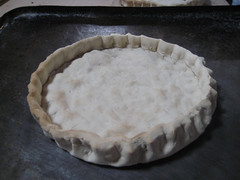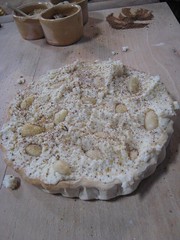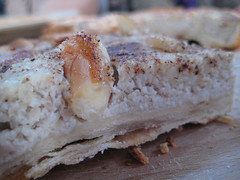Not a bad day today all things considered; although as I've commented on before, with these 'odd' weekends we do seem to get less made whilst talking so much more!
The biggest 'success' of the day was the recipe for
¶Flathouns in lente.
¶Take & draw a þrifty Milke of Almandes; temper with Sugre Water; þan take hardid cofyns, & pore þin comad þer-on; blaunche Almaundis hol, & caste ther-on Pouder Gyngere, Canelle, Sugre, Salt, & Safroun; bake hem, & serue forth.
Before we arrived I'd double checked on the medieval/Tudor meaning of the word thrifty because on first glance this recipe seems doomed to a sloppy failure......an ersatz custard with no setting agent!! As it happens thrifty means almost the opposite of what we would think today, the best way of thinking about it is 'fit for purpose' or 'suitable' so Marc H and I had a chat and decided to cook 2 versions. One with a wet almond milk and one with a much thicker paste type almond milk.....both with the lumps still in but one with much much less liquid.
So having had the paste cases blind baked



The second case was then filled with the more liquid milk

and then spiced and 'nutted' in the same way. They were then popped into the oven and watched until they began to colour before being removed........then came the 'oh' moment as the liquid tart had set solid!!


Pop over to the Flickr site to see some more pictures of both the variations being made. Hopefully more pictures to take tomorrow and a posting at the end of the day if you're lucky.

5 comments:
Did you use something like beans or peas to help the pastry cases keep their shape? Or, was the dough stiff enough and the oven temperature low enough that the sides didn't slump?
When I read your earlier post I agreed with your concern that this "custard" wouldn't set, but that was because I missed the note at the end that it was to be baked after the filling was poured into the crust (I have got to slow down and read more carefully).
Almond milk thickens very well when cooked. There are several custard-like recipes in the medieval corpus that use only almond milk as a thickener. The version I've made in the past (see URL below) is based on the for "Taillis" in Viandier de Taillevent and related recipes in Two Fifteenth-Century Cookery Books. Some of them add rice flour as well, but they work without.
"Lenten Slices"
http://www.medievalcookery.com/recipes/lenten.shtm
Nice pics, by the way. Makes me want to go do more cooking (Thanks!).
Elise,
best to see how Robin makes tart cases over at Youtube as the ones in the recent pictures aren't the best example. When they go into the oven and bear in mind that we are currently limited to using a modern oven, they go in as is and we keep an eye on them pushing any slump back into shape until the case is cooked enough to stay up itself. We've never had any joy using peas or the like as they've just stuck to the bottom of the case and been a swine to get out!!
"There are several custard-like recipes in the medieval corpus that use only almond milk as a thickener"
well quite and we've cooked quite a few of them in the past, but for some reason they've rarely thickened up sufficiently....probably due to using too thin an almond milk, so at least now we know what we're after in these cases.
Also, as we didn't expect the mixture on at least one of the tarts to set I made the decision to make the coffins from an dense inedible paste just in case we had to use them as a drinking bowl.
Marc H
Post a Comment